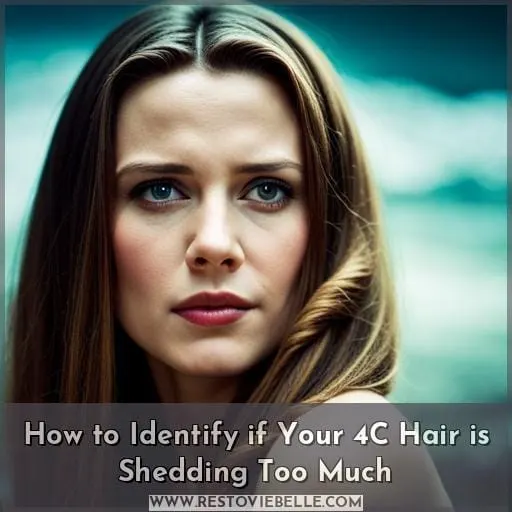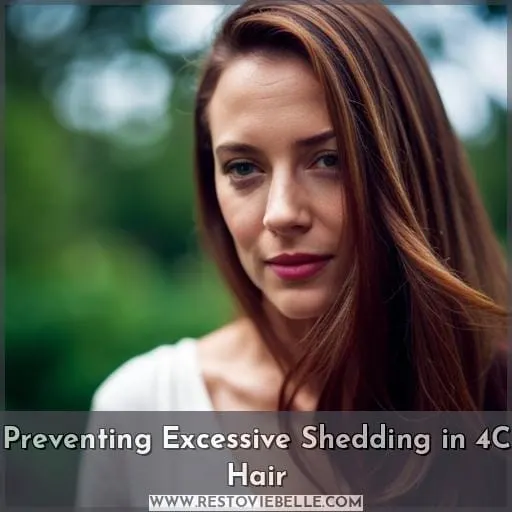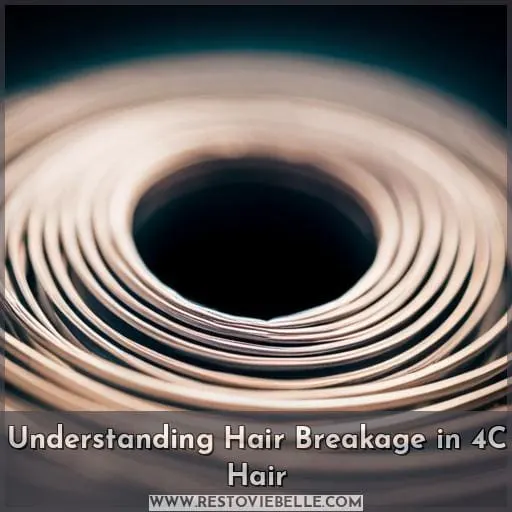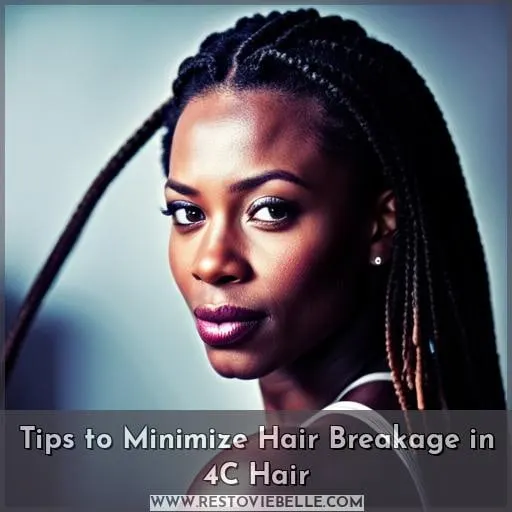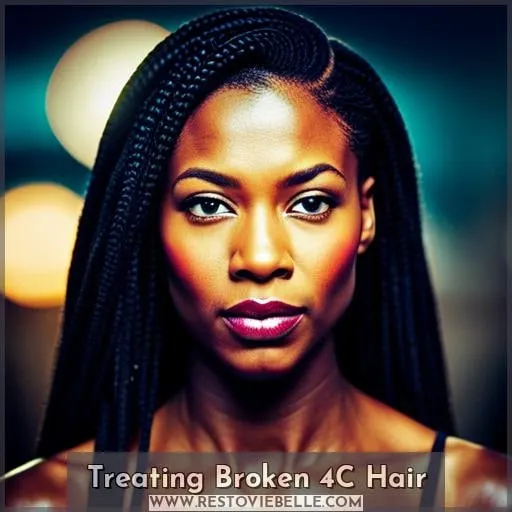This site is supported by our readers. We may earn a commission, at no cost to you, if you purchase through links.
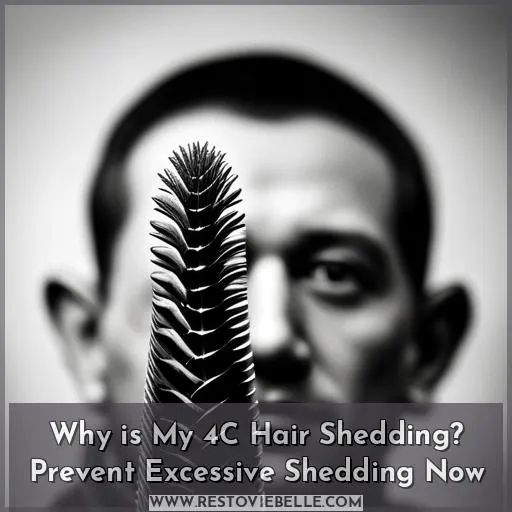 Do you feel as though your 4C hair is being pulled from the very roots? If so, it’s time to get to the root of this hair shedding issue. Excessive shedding can be a major problem for those with type 4C curls and coils, but luckily, there are strategies that can help reduce or even prevent it.
Do you feel as though your 4C hair is being pulled from the very roots? If so, it’s time to get to the root of this hair shedding issue. Excessive shedding can be a major problem for those with type 4C curls and coils, but luckily, there are strategies that can help reduce or even prevent it.
Table Of Contents
- Key Takeaways
- Understanding Hair Shedding and Breakage
- Is Excessive Shedding Normal for 4C Hair?
- How to Identify if Your 4C Hair is Shedding Too Much
- Preventing Excessive Shedding in 4C Hair
- Understanding Hair Breakage in 4C Hair
- Tips to Minimize Hair Breakage in 4C Hair
- Treating Broken 4C Hair
- Seeking Professional Help for Excessive Shedding and Hair Breakage
- Conclusion
Key Takeaways
- Shedding in 4C hair can be reduced or prevented through various methods.
- Causes of shedding in 4C hair can include genetics, diet, stress, or moisture levels.
- Recognizing the signs of excessive shedding is important, such as brittle, dry strands, split ends, tangles, and frizz.
- Preventing shedding in 4C hair can be achieved through natural oils, a protein-rich diet, managing stress, and ensuring a balanced diet with essential vitamins and minerals.
Understanding Hair Shedding and Breakage
Understanding the difference between shedding and breakage is essential for keeping 4C hair healthy. Shedding is a natural part of the hair growth cycle, while breakage occurs when strands are damaged due to heat styling or tight hairstyles.
Excessive shedding can be caused by stress, diet, and inadequate hydration or nutrition, whereas excessive breakage often results from over-manipulation of curls during styling.
Difference Between Shedding and Breakage
It’s essential to differentiate between shedding and breakage; recognizing the signs of each allows you to take actionable steps towards maintaining healthy hair. Shedding can be identified by strands with a white bulb at the root, while breakage is caused by damaged or split ends due to improper care practices.
Excessive shedding may be triggered by genetics, dietary deficiencies, stress, or lack of moisture. To prevent excessive shedding, try using natural oils like coconut and jojoba oil.
Hair breakage could result from heat styling tools or tight hairstyles. It’s best to opt for protective styles that reduce tension on 4C hair types. Regular haircuts also help maintain healthy locks, while deep conditioning treatments provide added hydration and strength against future damage.
Causes of Hair Shedding
You’re wondering why your ‘do is dunzo? Chances are, you could be dealing with excessive shedding due to a number of causes.
To prevent breakage and reduce shedding, consider nutritional strategies like incorporating biotin-rich foods or taking supplements for key nutrients like zinc and protein.
Stress triggers can also contribute to hair loss, so incorporate stress-relieving activities such as meditation or yoga into your daily routine.
Diet plays an important role too – make sure you’re getting enough essential vitamins and minerals from food sources!
Lastly, keep up with regular trims every 4-6 months as well as protective styling techniques when needed in order to maintain healthy 4C hair growth while avoiding unnecessary breakage.
Causes of Hair Breakage
Frighteningly, hair breakage can be caused by various activities such as heat styling and tight hairstyles, leaving your 4C hair vulnerable to damage. It’s important to prevent breakage through proper nutrition and hydration for healthy 4C hair.
Also key are the right haircare tips and techniques. This includes understanding shedding causes, limiting heat tools, moisturizing regularly, practicing protective styling, and choosing products carefully.
These measures must be implemented consistently in order to maintain strong strands.
If issues persist, seeking help from experts like nutritionists or trichologists may be necessary before consulting a healthcare professional if concerned about an underlying health condition causing excessive shedding or severe breakage.
Is Excessive Shedding Normal for 4C Hair?
You may be concerned if you’re experiencing excessive shedding with your 4C hair. It’s important to understand that a certain level of shedding is normal; however, there are factors that can contribute to excessive amounts.
Understanding these underlying causes will help you better manage the issue and keep your hair healthy and strong.
Normal Amount of Shedding
Knowing the amount of shedding that’s normal for your 4C hair can be daunting. It’s important to understand the difference between shedding and breakage, as well as its causes and prevention methods.
Improper hair care, such as heat styling or tight hairstyles, can contribute to excessive shedding. Stress levels should also be managed with relaxation practices like yoga or meditation to reduce stress-induced hair loss.
Proper detangling techniques are crucial for preventing breakage, while keeping strands moisturized by using water-based products will help maintain healthy locks too! Create a consistent routine based on your needs and don’t forget regular trims every 4-6 months to avoid split ends from forming in the first place!
Factors That Contribute to Excessive Shedding
Recognizing the factors that contribute to excessive shedding of 4C hair is key to maintaining healthy locks. Stress, hormonal imbalances, and nutrient deficiencies can all lead to an increase in shedding.
Improper care, such as heat styling or tight hairstyles, can also cause breakage, leading to more loss of strands.
A balanced diet rich in protein, iron, and vitamins B and D is essential for healthy hair growth. Regular moisturization with natural oils like jojoba or coconut oil will help keep your 4C tresses hydrated.
How to Identify if Your 4C Hair is Shedding Too Much
If you have 4C hair, it’s important to be aware of the signs of excessive shedding. Knowing how to determine if your hair loss is normal or a sign that something more serious is happening can help ensure your mane stays healthy and strong.
To start, examine the strands that are shed – if they have white bulbs at their root, then this indicates normal shedding; however, without these bulbs present, this could signal breakage due to heat styling or other activities that put stress on the follicle.
Signs of Excessive Shedding
It can be alarming to notice an uptick in the amount of strands you’re seeing fall out each day – a sign that your 4C hair is shedding too much. Signs of excessive shedding include misaligned, brittle, and dry strands; split ends; tangles; and excessive frizz.
Solutions for reducing shedding may include cutting out heat styling, co-washing instead of shampooing frequently, and opting for protective styles to minimize manipulation and tension. Additionally, using water-based moisturizers with natural oils like coconut or jojoba oil can help with hydration retention.
It’s also important to evaluate any underlying health issues or stress triggers that could contribute to increased hair loss. Furthermore, reviewing your nutritional intake, such as proteins, B vitamins, and iron, is crucial.
Lastly, consult a healthcare professional if necessary so they can help determine the best course forward towards healthier hair growth!
How to Determine if Hair Loss is Normal
To determine if your 4C hair is shedding too much, look for signs like misaligned strands and excessive frizz. Excessive shedding can be caused by a variety of factors such as nutrition deficiency, stress, or inadequate moisture.
If you notice an increase in the amount of hairs shed each day, it’s important to assess your lifestyle habits and current haircare routine.
Consider reducing heat styling tools and using products that are free from sulfates and silicones. Additionally, implementing protein treatments can help build strength in natural hair. Taking steps towards prevention early on will reduce the risk of long-term damage, so seeking consultation with a dermatologist or trichologist may be beneficial if necessary concerns persist.
Preventing Excessive Shedding in 4C Hair
It is essential to properly moisturize your 4C hair, follow nutritional recommendations, and manage stress levels in order to prevent excessive shedding. Regularly nourishing the scalp with natural oils like jojoba or coconut oil can help keep hair well-moisturized and strong.
Incorporating nutrient-rich foods into your diet will also provide extra support for healthy growth. Additionally, managing high stress levels through activities such as meditation or yoga can make a difference in reducing excessive shedding of 4C hair.
Proper Moisturization
Properly moisturizing your 4C hair is essential for keeping it healthy and preventing excessive shedding. A good start would be to use a microfiber towel or t-shirt to dry your hair instead of rubbing with a regular towel, which can cause breakage.
Protective styling helps minimize manipulation and tension on the strands. Deep conditioning treatments are great for infusing moisture into the strands.
Additionally, nutritional support plays an important role in maintaining healthy hair. So make sure you’re getting enough vitamins, such as B vitamins, iron, zinc, and omega 3 fatty acids from food sources or supplements if needed.
Finally, remember that consistency is key when it comes to any natural haircare routine!
Nutritional Recommendations
Fueling your hair with the proper nutrients can help keep it looking healthy and vibrant. Key nutrients for a healthier head of 4C hair include zinc, protein, iron, vitamin D, and omega-3 fatty acids. Incorporating these into your diet or taking supplements may be beneficial in preventing breakage.
Additionally, incorporating daily hydration through natural oils like coconut or jojoba oil is essential to maintaining healthy locks. Hair care routines that involve cleansing and moisturizing should also be implemented regularly to prevent split ends from forming due to dryness.
Identifying triggers such as stress levels is important, as they can lead to excessive shedding.
Stress Management
Managing your stress levels can go a long way in keeping 4C hair healthy and strong. Utilize stress management techniques such as meditation, yoga, or even scalp massages to help reduce tension and strengthen weak 4C hair.
Consider protective hairstyles like braids, buns, or twists that are less likely to tangle and cause breakage. Additionally, use gentle haircare products designed specifically for curly textures.
Nutrition also plays an important role. Make sure you’re getting the essential vitamins and minerals needed for healthy growth through dietary sources or supplements when necessary. If you’re still experiencing issues with shedding despite following these steps, seeking professional advice from dermatologists, nutritionists, or trichologists may be beneficial.
Understanding Hair Breakage in 4C Hair
If you have 4C hair, it’s important to be aware of the signs and common causes of breakage. Split ends, tangles, excessive frizz – these are all indications that your hair is in distress. Heat styling tools and tight hairstyles can also contribute to weakened strands that may eventually lead to breakage.
Knowing the source of your shedding will help you make informed decisions when it comes time for a new style or treatment plan.
Signs of Hair Breakage
Soak up the signs of hair breakage like a sponge – split ends, tangles, and excessive frizz – which can be clues that your 4C hair needs some TLC. To prevent further damage: limit heat styling tools; avoid towel drying; moisturize regularly using water-based products; embrace protective styles to reduce manipulation and tension when detangling; schedule regular trims every four to six months for split end removal.
Additionally, amp up nutrition with biotin-rich foods or protein treatments for added strength.
Common Causes of Hair Breakage
Uncovering the common causes of hair breakage in 4C hair is key to keeping it healthy and strong. Heat styling, tight hairstyles, harsh chemical products like sulfates and silicones can all lead to misaligned strands or dry hair that’s prone to breaking.
Poor moisture retention due to inadequate hydration or nutrition can also disrupt the hair growth cycle, leading to excessive shedding with a white bulb at the root when detangling.
Tips to Minimize Hair Breakage in 4C Hair
With 4C hair being fine and fragile, it is often more prone to breakage. To prevent this, it’s important to take precautions when heat styling, use gentle handling techniques, and opt for protective styles.
By avoiding excessive manipulation of the natural coils or curls, using a high-quality heat protectant spray prior to styling with heated tools like curling irons or blow dryers, and considering protective hairstyles such as braids or twists that help reduce friction on strands while keeping them in place, you can minimize damage caused by breakage.
Heat Styling Precautions
When it comes to heat styling, always practice caution and take necessary steps to prevent your 4C hair from breakage. Protective styles can help preserve moisture balance as they reduce the amount of manipulation on the strands during styling.
Incorporating nutritional support with biotin-rich foods and other micronutrients like zinc, protein, iron, vitamin D, and omega-3 fatty acids will also promote healthier hair growth and minimize breakage due to poor nutrition.
Try using low temperature settings when heat styling or opt for air drying instead if possible as this helps protect delicate strands from damage caused by excessive heating.
Additionally, use a Heat Protectant spray before applying any hot tools onto your scalp or hair, which creates a protective barrier that prevents it from being broken down by harsh temperatures.
Gentle Hair Handling Techniques
Gently handling your 4C hair is key to minimizing breakage and preserving its natural beauty, so take the time to detangle with patience and care.
Effective detangling methods include finger-detangling or using wide-toothed combs on wet hair followed by an oil or conditioner.
Protective styles like buns, braids, and twists can also help protect the ends of your strands from damage.
Keeping a balanced moisture level through regular conditioning treatments helps maintain healthy scalp environments, reducing common hair concerns such as shedding and breakage.
Hair cutting techniques, such as dusting, are also effective in removing split ends without having to cut off significant lengths of the strand, maximizing growth potential over time.
Protein treatments can help strengthen brittle 4C hair, while avoiding towel drying should be incorporated into routine practices when possible for extra protection against frizziness that may lead to further breakages later on.
Protective Styling Options
Protect your locks and prevent breakage with the perfect protective style! Braiding techniques, such as box braids, cornrows, and twists, can help reduce hair manipulation. Protective styles also retain moisture better than other hairstyles while protecting against heat damage.
Hair accessories like satin or silk scarves are great for nighttime care to protect curls from friction while sleeping. Pre-poo treatments before washing will also minimize damage when detangling hair.
Follow this up with leave-in conditioners to restore hydration levels after shampooing or conditioning.
For extra nourishment, consider steaming 4c hair during deep conditioning sessions for maximum benefits of nutrient absorption into strands! Whatever option you choose is sure to keep your mane healthy and strong so that it may reach its full potential!
Treating Broken 4C Hair
If you’re trying to treat broken 4C hair, protein treatments and steaming can be an effective way to strengthen it. Protein treatments work by repairing the damage that has already been done, while steaming helps infuse your hair with moisture for added shine and elasticity.
Both of these techniques can help restore strength so that your curls look fuller, healthier, and more vibrant than ever before.
Protein Treatments for Hair Strengthening
Reinvigorate your 4C hair with a nourishing protein treatment to strengthen and repair brittle strands. Protein treatments are essential for the health of natural hair as they help restore strength and elasticity, reduce breakage, prevent shedding, and promote healthy hair growth.
Deep conditioning is also beneficial in treating dryness or damage caused by heat styling or chemical treatments. To maximize the results from these treatments, opt for high-quality products designed specifically for natural textures such as 4C hair types.
You can find these products at beauty supply stores or online retailers that specialize in natural haircare products.
Use weekly deep conditioning sessions along with regular moisturizing practices like co-washing to keep your curls hydrated.
Benefits of Steaming During Deep Conditioning
Steaming your 4C hair during deep conditioning can help infuse moisture into the strands, making them stronger and less prone to breakage. It also aids in deeper penetration of conditioners for better hydration retention.
Additionally, steaming improves circulation in the scalp, reducing shedding and promoting healthy hair growth. Moreover, it increases blood flow, delivering essential nutrients more efficiently throughout each strand, resulting in improved elasticity and overall strength over time.
With regular steaming treatments, combined with a well-balanced diet, you’ll be able to achieve healthier-looking natural hair that can withstand breakage!
Seeking Professional Help for Excessive Shedding and Hair Breakage
If you’re struggling with excessive shedding or hair breakage, it might be time to consider seeking professional help. Consulting a trichologist or dermatologist can provide tailored advice for your particular situation and set you on the path towards healthy 4C hair.
With their expertise, they can identify potential causes of damage and suggest an individualized plan of action to restore balance and strength in your strands.
When to Consult a Trichologist or Dermatologist
If you’re still noticing excessive shedding or hair breakage, it may be time to consult a trichologist or dermatologist. But have you tried any of the aforementioned treatments first? Moisturizing with natural oils, limiting heat styling, and using protective styles can all help prevent damage.
Eating a healthy diet rich in biotin-rich foods for stronger hair can also promote healthy growth.
If these strategies haven’t worked, seeking professional advice from experts like trichologists and dermatologists is key for finding an effective solution that works best for your individual needs.
Importance of Tailored Hair Care Advice
Receiving tailored hair care advice from a trichologist or dermatologist is essential to identify the cause of excessive shedding and breakage, as well as find an effective solution for your 4C hair.
- Get personalized guidance on diet and lifestyle changes that can improve the health of your natural hair.
- Access tailored advice based on individual needs such as scalp condition, texture, porosity level, etc.
- Receive recommendations about products specifically designed to target common issues associated with 4C natural hair.
- Learn techniques from experts like Leah Marie Priest, who specialize in helping people manage their shedding solutions.
Professional guidance can be invaluable when it comes to addressing problems related to excessive shedding and breakage in 4C Hair, empowering you with knowledge so that you have control over achieving healthy locks!
Conclusion
After spending months trying to figure out why her 4C hair was shedding so much, Carly finally found the answer and the solution she was looking for. She learned that excessive shedding in 4C hair can be caused by improper moisturization, nutritional deficiencies, and high levels of stress.
By addressing these issues, Carly was able to reduce her shedding and increase her hair’s health. She also discovered the importance of using heat styling precautions, gentle detangling techniques, and protective styling options to minimize hair breakage.
With the help of her trichologist, Carly found the right hair care routine for her and is now able to enjoy healthy, strong, and beautiful 4C hair. Now Carly knows that with the right knowledge and the right products, she can keep her 4C hair looking and feeling its best.


